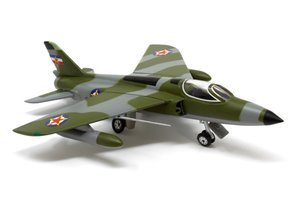F16C Fighting Falcon Turkish Air Force, 192 Filo "Kaplan", Tiger Meeting 2016
| Model manufacturer: | JC Wings |
| Order code: | JCW-72-F16-014 |
| Scale: | 1:72 |
| Material: | Combined (Metal / Plastic) |
| EAN: | 4895205501614 |
| Weight: | 0.9 kg |
| Dimensions: | 20.9×13.9×7 cm (L×W×H) |
| Air company: | Turkish Air Force |
| Aircraft manufacturer: | General Dynamics/Lockheed |
Product description
Limited series of 500 pieces of metal-plastic model of military fighter F16C Fighting Falcon Turkish Air Force, 192 Filo "Kaplanlar", Tiger Meeting 2016. Packaging, paper box contains accessories, instructions and registration card with serial number of the model.
192 Squadron was established in 1948 as 102 Fighter Bombing Squadron at Balikesir, Turkey, operating then the P-47 Thunderbolt. They adopted the Tiger in their patch in 1950. In 1952 the Squadron was named 192 Squadron and receives the F-84. Between 1952 and 1970 they fly the F-84 F/G and the RF-84 F Thunderstreak, in Attack and Reconnaissance missions. The RF-5 were flown between 1970 and 1975.
On September 1976 they converted to the F-104, with the mission of defending the Turkish air space. They get more responsibilities, between 1984 and 1988, when they become one of the "All Weather" Squadrons assigned to NATO.
On March 1993 40 F-16 C/D arrived at Balikesir, and the squadron gets Air-to-Ground added to their mission.
192 Squadron became a member of NATO Tiger Society in 1980, and has organized and hosted a Mini-Tiger Meet in 1995 in Balikesir.
In 1994 and 1997 this Squadron was deployed to Italy to take part in the peacekeeping operations over Bosnia.
192 Filo converted to the F-16 in 1992. It was the second Turkish squadron to fly with the block 50 version of the Fighting Falcon. Previous orders had compromised both block 30 and block 40 airframes. With the Peace Onyx II and III orders, the newer block 50’s were ordered.
Although the squadron is equipped with the advanced block 50 version of the F-16, the squadron did not incorporate the SEAD mission as in the other block 50 squadrons, but kept it’s main air defence mission. This was mainly because the Turkish Air Force lacked serious air defence assets of other fighters at the time the F-16 was put in service, so it was obliged to have some F-16 squadrons being used solely for air defence missions. Besides this task, they have a dedicated strike role. Nuclear weapons were previously located on base, but since 1996 the vaults have been placed in caretaker status and weapons were moved to Incirlik AB.
Since a number of years, all F-16s squadrons within the Turkish Air Force are multi-role. This means they can handle all missions, but are specialised in one. With the CCIP program – which will start in 2009 – the aircraft will get an upgrade which will prolong their service life and introduce a completely new cockpit and advanced electronics. This upgrade will enhance the aircraft even further to carry new kind of weapons and introduce new technologies which were not available at the time when the contract for these fighters was signed.





















